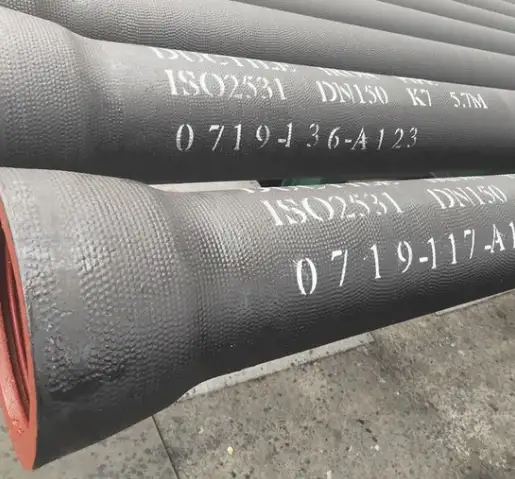Ductile iron pipes are integral components in modern infrastructure, serving as the backbone for water distribution and wastewater systems worldwide. Understanding the weight of these pipes is crucial for engineers, contractors, and project planners to ensure proper handling, transportation, and installation. This article delves into the specifics of a 6-inch ductile iron pipe‘s weight, exploring various factors that influence it, and providing comprehensive insights into its applications and considerations.

1. Standard Weight of a 6-Inch Ductile Iron Pipe
According to the American Water Works Association (AWWA) standards, a 6-inch ductile iron pipe typically weighs approximately 22 pounds per foot. This weight is based on a Class 53 pipe with a wall thickness of 0.34 inches. When filled with water, the total weight increases to about 35 pounds per foot, considering the density of water at 62.4 pounds per cubic foot.
2. Factors Influencing the Weight of Ductile Iron Pipes
2.1 Pipe Diameter
The nominal diameter of the pipe directly impacts its weight. Larger diameters require more material, thereby increasing the pipe’s weight. For instance, while a 6-inch pipe weighs about 22 pounds per foot, an 8-inch pipe can weigh up to 31 pounds per foot, and a 10-inch pipe can weigh approximately 40 pounds per foot.
2.2 Wall Thickness Class
Ductile iron pipes are manufactured in various thickness classes, such as Class 50, Class 51, and Class 53, as per AWWA C151 standards. A higher class indicates a thicker wall, which adds to the pipe’s weight. For example, a 6-inch Class 50 pipe weighs less than a 6-inch Class 53 pipe due to the difference in wall thickness.
2.3 Pipe Length
The standard length for ductile iron pipes is typically 18 feet. However, custom lengths are available, and the weight of the pipe will proportionally increase with length. For instance, a 6-inch Class 53 pipe weighing 22 pounds per foot would weigh approximately 396 pounds for an 18-foot length.
2.4 Joint Type
The type of joint used in the pipe also affects its weight. Common joint types include push-on joints, mechanical joints, and flanged joints. Each joint type has different components that can add to the overall weight of the pipe.
2.5 Coatings and Linings
Ductile iron pipes are often coated and lined to prevent corrosion and enhance durability. The type and thickness of the coating or lining can add to the pipe’s weight. For example, cement mortar linings are commonly used and can slightly increase the pipe’s weight.
3. Weight Comparison Table
| Pipe Size (Inches) | Wall Thickness (Inches) | Weight per Foot (Pounds) | Weight per 18-Foot Length (Pounds) |
|---|---|---|---|
| 6 | 0.34 | 22 | 396 |
| 8 | 0.36 | 31 | 558 |
| 10 | 0.38 | 40.4 | 727.2 |
| 12 | 0.40 | 50.7 | 912.6 |
| 14 | 0.42 | 62.4 | 1123.2 |
Note: The weights are approximate and can vary based on manufacturer specifications and additional factors.
4. Importance of Understanding Pipe Weight
4.1 Transportation and Handling
Knowing the weight of ductile iron pipes is essential for planning transportation logistics. Overloading transport vehicles can lead to safety hazards and increased costs. Proper handling ensures the integrity of the pipes during transit and reduces the risk of damage.
4.2 Installation Planning
Accurate weight information aids in selecting appropriate lifting equipment and determining manpower requirements for installation. This ensures efficiency and safety on the construction site.
4.3 Structural Design
Engineers use pipe weight data to design support structures and calculate load-bearing capacities. This is crucial for maintaining the stability and safety of the entire pipeline system.
5. Frequently Asked Questions (FAQs)
5.1 How does the wall thickness class affect the weight of a ductile iron pipe?
The wall thickness class determines the amount of material used in the pipe’s construction. A higher class indicates a thicker wall, which increases the pipe’s weight. For instance, a 6-inch Class 53 pipe weighs more than a 6-inch Class 50 pipe due to the increased material.
5.2 Why is it important to know the weight of ductile iron pipes?
Understanding the weight is vital for transportation, handling, and installation planning. It ensures that appropriate equipment is used and that safety standards are met.
5.3 Can the weight of a ductile iron pipe vary between manufacturers?
Yes, slight variations can occur due to differences in manufacturing processes, materials used, and adherence to standards. It’s essential to refer to the specific manufacturer’s data for precise information.
5.4 How does the joint type influence the overall weight?
Different joint types have varying components, such as gaskets and bolts, which add to the total weight of the pipe. For example, flanged joints typically weigh more than push-on joints due to additional hardware.
5.5 Does the coating or lining affect the pipe’s weight?
Yes, coatings and linings, such as cement mortar or epoxy, add to the pipe’s weight. The type and thickness of the coating determine the extent of the weight increase.
5.6 How can I calculate the weight of a ductile iron pipe?
The weight can be calculated using the formula:
Weight per Foot (lbs) = (π × (OD² – ID²) × Density) / 4
Where:
-
OD = Outside Diameter
-
ID = Inside Diameter
-
Density = Density of Ductile Iron (approximately 440 lb/ft³)
For a 6-inch pipe with an OD of 6.9 inches and an ID of 6.27 inches:
Weight per Foot = (π × (6.9² – 6.27²) × 440) / 4 ≈ 22 lbs
Note: This is a simplified calculation and actual weights may vary based on specific standards and coatings.
6. Conclusion
Understanding the weight of a 6-inch ductile iron pipe is essential for various aspects of pipeline construction and maintenance. Factors such as wall thickness, joint type, and coatings can influence the overall weight, which in turn affects transportation, handling, and installation processes. By considering these factors and utilizing accurate weight data, professionals can ensure the efficiency and safety of their projects.

